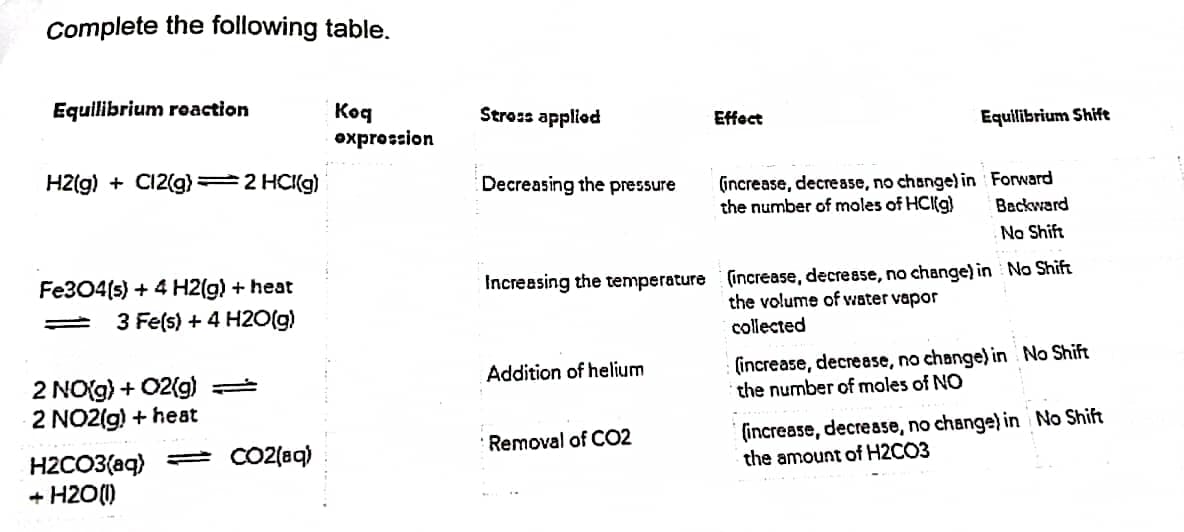Complete the following table. Equilibrium roaction Koq expression H2(g) + C12(g) = 2 HCI(g) Fe3O4(s) + 4H2(g) + heat 3 Fe(s) + 4H2O(g) 2 NO(g) + O2(g) 2 NO2(g) + heat H2CO3(aq) = CO2(aq) + H20 (1) Stross applied Effect Decreasing the pressure (increase, decrease, no change) in Forward the number of moles of HCI(g) Backward No Shift Increasing the temperature increase, decrease, no change) in No Shift the volume of water vapor collected Addition of helium (increase, decrease, no change) in No Shift the number of moles of NO Removal of CO2 (increase, decrease, no change) in No Shift the amount of H2CO3 Equilibrium Shift
Complete the following table. Equilibrium roaction Koq expression H2(g) + C12(g) = 2 HCI(g) Fe3O4(s) + 4H2(g) + heat 3 Fe(s) + 4H2O(g) 2 NO(g) + O2(g) 2 NO2(g) + heat H2CO3(aq) = CO2(aq) + H20 (1) Stross applied Effect Decreasing the pressure (increase, decrease, no change) in Forward the number of moles of HCI(g) Backward No Shift Increasing the temperature increase, decrease, no change) in No Shift the volume of water vapor collected Addition of helium (increase, decrease, no change) in No Shift the number of moles of NO Removal of CO2 (increase, decrease, no change) in No Shift the amount of H2CO3 Equilibrium Shift
World of Chemistry, 3rd edition
3rd Edition
ISBN:9781133109655
Author:Steven S. Zumdahl, Susan L. Zumdahl, Donald J. DeCoste
Publisher:Steven S. Zumdahl, Susan L. Zumdahl, Donald J. DeCoste
Chapter17: Equilibrium
Section: Chapter Questions
Problem 31A
Related questions
Question
Complete the table by filling up the Keq expression

Transcribed Image Text:Complete the following table.
Equilibrium reaction
H2(g) + C12(g) = 2 HCl(g)
Fe3O4(s) + 4H2(g) + heat
= 3 Fe(s) + 4H2O(g)
2 NO(g) + O2(g) =
2 NO2(g) + heat
H2CO3(aq) = CO2(aq)
+ H20 (1)
Koq
expression
Stross applied
Effect
Decreasing the pressure
(increase, decrease, no change) in Forward
the number of moles of HCl(g) Backward
No Shift
Increasing the temperature (increase, decrease, no change) in No Shift
the volume of water vapor
collected
Addition of helium
(increase, decrease, no change) in No Shift
the number of moles of NO
Removal of CO2
(increase, decrease, no change) in No Shift
the amount of H2CO3
Equilibrium Shift
Expert Solution
This question has been solved!
Explore an expertly crafted, step-by-step solution for a thorough understanding of key concepts.
Step by step
Solved in 2 steps with 1 images

Knowledge Booster
Learn more about
Need a deep-dive on the concept behind this application? Look no further. Learn more about this topic, chemistry and related others by exploring similar questions and additional content below.Recommended textbooks for you

World of Chemistry, 3rd edition
Chemistry
ISBN:
9781133109655
Author:
Steven S. Zumdahl, Susan L. Zumdahl, Donald J. DeCoste
Publisher:
Brooks / Cole / Cengage Learning

Chemistry & Chemical Reactivity
Chemistry
ISBN:
9781133949640
Author:
John C. Kotz, Paul M. Treichel, John Townsend, David Treichel
Publisher:
Cengage Learning

Chemistry: The Molecular Science
Chemistry
ISBN:
9781285199047
Author:
John W. Moore, Conrad L. Stanitski
Publisher:
Cengage Learning

World of Chemistry, 3rd edition
Chemistry
ISBN:
9781133109655
Author:
Steven S. Zumdahl, Susan L. Zumdahl, Donald J. DeCoste
Publisher:
Brooks / Cole / Cengage Learning

Chemistry & Chemical Reactivity
Chemistry
ISBN:
9781133949640
Author:
John C. Kotz, Paul M. Treichel, John Townsend, David Treichel
Publisher:
Cengage Learning

Chemistry: The Molecular Science
Chemistry
ISBN:
9781285199047
Author:
John W. Moore, Conrad L. Stanitski
Publisher:
Cengage Learning

Chemistry
Chemistry
ISBN:
9781305957404
Author:
Steven S. Zumdahl, Susan A. Zumdahl, Donald J. DeCoste
Publisher:
Cengage Learning

Chemistry: An Atoms First Approach
Chemistry
ISBN:
9781305079243
Author:
Steven S. Zumdahl, Susan A. Zumdahl
Publisher:
Cengage Learning
